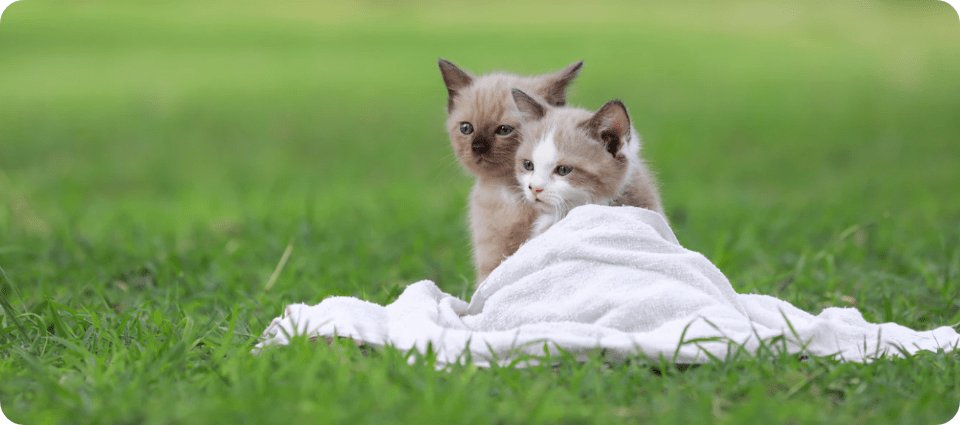
Top 8 tips on how to take care of a cat
Whether you affectionately refer to your cat as your furbaby, Mr. Cuddles (or Claws) or even Kit Cat, it is a given that your feline friend has worked their way into your heart and that you love them deeply.
There are very few things in life that bring us the same joy as our pets do. In order to ensure that you are taking the best care of your cat and giving them a happy and fulfilled life, here are our top cat care tips that you can start implementing today.
1. Provide sufficient water points for your cat
Did you know that domesticated felines come from genetic lines that survived in harsh dry climates. This means that cats are better able to adapt than dogs when it comes to the low availability of water.
Water is generally obtained from the prey they hunt. Most of their food sources are high in water, for example a bird ranges from between 60% to 80% water depending on where they are in their life cycle. While wet tinned cat food is about 75% water which is sufficient to provide for the cat’s water requirements.
Meanwhile, dry cat food is, well, dry. It contains very little water, and this means cats eating dry food need to have fresh water available to them.
Our advice is to place a couple, or even a few, bowls of freshwater around the house to ensure there is always some water available. Elderly cats with kidney disease will often stop drinking so it is also very important to keep an eye on how much your cat is drinking so that you can act quickly should you need to.
2. Moderate the amount of dry food that you feed your cat
Cats are ultimately carnivores, not herbivores. They need meat to be the major food source. Dry cat food can provide too many unhealthy carbohydrates which are not good for cats at all. Their systems struggle to process carbohydrates in the same manner that dogs and other animals can. This can lead to severe obesity as well as type 2 diabetes.
With this in mind, it becomes obvious that you should never feed your cat dog food. Provide enough meat in the form of fresh or cooked meat, fish or poultry, or wet canned food. Go easy on the vegetables, those are for rabbits and not cats, ok?
Meanwhile, dry cat food is, well, dry. It contains very little water, and this means cats eating dry food need to have fresh water available to them.
Our advice is to place a couple, or even a few, bowls of freshwater around the house to ensure there is always some water available. Elderly cats with kidney disease will often stop drinking so it is also very important to keep an eye on how much your cat is drinking so that you can act quickly should you need to.
3. Get your cat neutered or spayed
This is as important to your cat as it is to you. Anyone who has a female cat that has not been spayed will know that cats that are not spayed will have kittens. I mean lots of kittens, over and over.
Being on heat can also stress the little kitty out just as much as it stresses the owners. One female on heat will bring all the male cats that are not neutered right to your garden and in some cases right into your house.
Now, male cats love to spray. And cat owners will know that the scent produced by male cats is one of the most offensive to your nostrils. It also hangs around through multiple washes and treatments. Yuck!
Another thing that happens when males are vying for mating rights to the female is that they will fight, and howl, and shriek. Cat fights are all excellent methods for cats to spread viruses and diseases to each other. Bites or scratches often form abscesses that need veterinary care quickly.
If you are not adopting a shelter cat, then at the very least do your part not to add to the enormous number of cats that have no homes to go to.
4. Make it a daily habit to brush or comb your cat
Let’s be honest, all that hair being consumed during constant grooming can’t be great for a kitty’s digestive system.
Hairballs do and will develop inside the stomach and intestines. This can cause discomfort if the hairballs are excessively large or many in number. These hairballs cause discomfort and require the cat to expel them with effort.
Giving your cat a brush every day will remove any loose hair and cut down on the amount consumed. Now, if your furry friend is a little, or a lot, niggly when it comes to brushing time, try to brush during a happy time like just before eating or before getting treats. This should go a long way in getting the cat to embrace the brushing. Often cats begin to enjoy the grooming as it is all your attention fixed just on them. We know cats love that.
5. Provide enough places for kitty to potty
Toilet time for cats is a little stressful, this is one of the times that cats are most vulnerable.
For this reason, when cats are using a litter box, they prefer to see all around them. This helps them to identify any threat before it is too late. Keep this in mind when deciding where to place the litter box.
In most cases, we like to hide the litter box or place it somewhere where people do not frequent, like in an attic or basement. This is natural as these litter boxes can really odorise your dwelling. But, as we have just mentioned, cats are rather particular about where they relieve themselves so the area you have chosen may not be suitable for kitty.
The same goes for litter trays with covers, cats might refuse to use them as they obstruct their view. We have not touched on the number of litter trays that you should provide for each cat. We suggest at least one litter box per cat and one spare. So, if you have one cat then you need two litter boxes. If you have two cats, we recommend having one for each plus one spare, giving you three litter boxes.
It is obvious that these litter boxes must be cleaned daily. The smell will remind you. On that note, be careful that you do not become used to the smell so much that you do not even notice it. Trust me, your visitors do.
6. Pay attention to your cat’s behaviour
If you are not a ve or an animal behaviour expert, this could seem like an impossible ask. But paying attention to your cat’s behaviour will help you to identify if something is wrong.
For example, if your cat is urinating all over your house, usually on your favourite piece of furniture, brand-new carpet or luxury bedding, it could be a sign of a bigger problem. There are many reasons why cats will relieve themselves anywhere but in the litter box. Some of the reasons could be linked to trying to one-up you or to show displeasure for something you maybe did or didn’t do.
And, while some of the reasons are not serious (besides getting the smell out), they can be very serious, and it can be a sign that your cat is ill and needs some attention from the vet.
Illness like kidney failure or a urinary tract infection are just two of the reasons why your furry child is messing all over your house. These are serious issues and kidney disease can and often does lead to death if not treated.
Once you have ruled out illness, try moving the litter boxes into various locations like a quiet corner or any area where the cats can access them easily. As mentioned already, it is imperative that the boxes are cleaned out daily or even immediately after being used.
7. Provide enough toys and scratch posts to keep the kitty entertained
This one is even more important for people who live in apartments and flats than it is for those in houses with gardens.
Cats need something to occupy their time. Something to play with and something to scratch. If you really love your furniture, then it is wise to teach the kitty how to use a scratch post or scratchpad. In the garden trees and small animals and insects provide entertainment and a suitable place to sharpen those claws. And trust me, all cats need to sharpen their claws so it is either you provide something, or the cat will choose something to use.
At first, your cat may show no interest in the new scratchpad or post but there are a few ways to get them to use it. Place the post or pad somewhere where there is a fair amount of activity to start. Cats generally hang out where their owners are so if there is a scratch post nearby, they might just start to use it. If your cat is still hesitant, a sprinkle of catnip over the pad or post is likely to get the job done.
Once the kitty is using the post or pad daily, slowly begin to move it to another area that is a bit less in the way but don’t go hide it inside the basement.
8. Recognise, receive and return your cat’s love
Cats have fun and sometimes really gross ways of showing that they love you.
You need to know when your cat is showing affection so that you can react appropriately and receive the affection as it was meant to be received. Things like bunting, head bumping, kneading your legs with their claws and purring are just some examples.
When it comes to bunting or head bumping, it can mean two things. It is showing you that you are part of the family by allowing you to be in a position that makes them vulnerable thus showing trust. Or it could be that your cat is scent marking you (which is kind of cute) and making sure any other cat knows that you are taken.
Of course, one of the most common shows of affection is the delivery of a headless lizard or mouse promptly dropped at your feet or placed in your bed as a loving surprise. Accept the gift with gratitude and show the kitty you appreciate the gift.
Last words of cat wisdom:
Remember that you never own a cat. Your cat owns everyone in the household, including the dog.
Are you interested in learning more about how to take care of a cat? Don’t hesitate to sign up for our cat care course.



